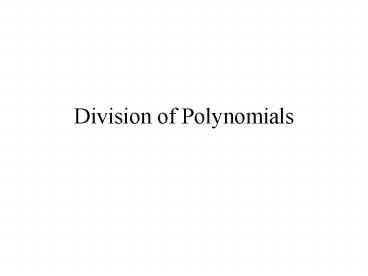Division of Polynomials - PowerPoint PPT Presentation
1 / 19
Title:
Division of Polynomials
Description:
Division fact, when it multiplies the divisor, the product must be equal to the dividend. ... each term to its opposite. Combine like terms. Bring down the next ... – PowerPoint PPT presentation
Number of Views:104
Avg rating:3.0/5.0
Title: Division of Polynomials
1
Division of Polynomials
2
Division by a Monomial
When dividing monomials with Exponential
expressions, use the Quotient Rule of Exponents
if x 0
3
When subtracting exponents, you might get a
zero or a negative exponent. Thus, remember to
use the Zero - Exponential Rule and the Negative
Exponential Rule
x0 1,
If x 0
4
Example 1
Divide coefficients
Divide terms with the same bases
- 5 x y 4
x has degree 1 1 can be omitted
5
Example 2
6
Dividing a Polynomial by a Monomial
If a polynomial of more terms is divided by a
monomial, divide each term of the polynomial by
the monomial. Remember! Always think about which
term is positive or negative
7
For example
Remember to divide 3y into every term
y4 4y3 6y
8
Dividing a Polynomial by a Binomial
Example
(x3 4x2 2x 6) ? (x 2)
Divisor
Dividend
We are to find the Quotient to which, by
Division fact, when it multiplies the divisor,
the product must be equal to the dividend.
9
The solution to this question can be found by
Long Division, and it usually written in the form
Dividend Divisor
Remainder Divisor
Quotient
Long Division can be checked by the following
fact
Dividend Quotient ? Divisor Remainder
10
Long Division Algorithm
When the divisor has more than one term, we will
need to find the Quotient by using Long
Division. Here is the process of the Algorithm
of Long Division
11
- Arrange all the terms of both dividend
- and divisor from the highest degree to the
lowest degree. Set up division as example shown
(4x2 2x 5) ? (x 2)
Then set up the problem as follows
)
4x2 2x 5
x 2
12
- Find the first term of the Quotient by
- dividing the first term of the dividend
- by the first term of the divisor, as shown.
Divide 4x2 by x 4x
4x
)
4x2 2x 5
x 2
13
- Multiply every term of the divisor by
- the first term of the quotient, 4x, and
- write the result as shown.
4x
)
4x2 2x 5
x 2
4x2 8x
Multiply 4x (x2)
14
- Subtract the product from the dividend
- by changing the signs of every term
- of the product to opposite, then add
- like terms.
4x
)
4x2 2x 5
x 2
4x2 8x
Change the sign of each term to its opposite
- 6x
Combine like terms
15
- Bring down the next term, write it next
- to the first remainder as shown
4x
)
4x2 2x 5
x 2
Bring down The next term
4x2 8x
6x 5
16
- Use this last expression as the dividend,
- then repeat the process from step 1 until
- the remainder can not be divided any
- further.
4x 6
)
4x2 2x 5
x 2
4x2 8x
-- 6x
6x 5
Divide - 6x by x -6 , write 6 next to the
first term of the quotient, 4x.
17
The entire process of this long division is now
shown as follows.
quotient
4x 6
divisor
)
4x2 2x 5
x 2
4x2 8x
4x (x2)
6x 5
-6 (x 2)
6x 12
7
remainder
18
We can express the result of this long Division
as follows
19
4x2 8x 6x 12 7
and check by showing that the product of the
quotient and the divisor, plus the remainder is
equal to the dividend.
divisor
remainder
Quotient
(4x 6)(x 2) (7)
dividend
4x2 2x 5































